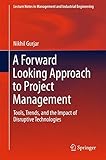A Forward Looking Approach to Project Management [electronic resource] : Tools, Trends, and the Impact of Disruptive Technologies / by Nikhil Gurjar.
By: Gurjar, Nikhil [author.] .
.
Contributor(s): SpringerLink (Online service) .
.
Material type:  BookSeries: Lecture Notes in Management and Industrial Engineering: Publisher: Singapore : Springer Nature Singapore : Imprint: Springer, 2017Edition: 1st ed. 2017.Description: XXX, 401 p. 133 illus., 15 illus. in color. online resource.Content type: text Media type: computer Carrier type: online resourceISBN: 9789811007828.Subject(s): Industrial engineering
BookSeries: Lecture Notes in Management and Industrial Engineering: Publisher: Singapore : Springer Nature Singapore : Imprint: Springer, 2017Edition: 1st ed. 2017.Description: XXX, 401 p. 133 illus., 15 illus. in color. online resource.Content type: text Media type: computer Carrier type: online resourceISBN: 9789811007828.Subject(s): Industrial engineeringI A Reality Check -- Introduction -- Basic Misconceptions in Projects -- A Quick Honest Beginning! -- II Reviewing Projects: First Level -- The Systems View of Management - I -- The Systems View of Management - II -- Basic Mantras of Project Management -- III Management and Business Review -- Second Level Review - I -- Second Level Review - II -- Second Level Review - III -- IV Active Project Risk Management -- Basics Mantras of Risk Management -- How Risky Is Your Risk Management? -- Project Management in R&D -- Tools in Risk Management -- V Project Planning and Scheduling -- Basics of Scheduling -- Advanced Planning and Schedule Analysis -- More Advanced Planning -- VI Project Procurement Management -- Procurement: Commercial Risks Dimension -- Account Management -- Public Private Partnerships in Projects -- Key Mantras in PPP -- VII Other Project Areas -- People Dimensions.
This book is intended as a basis for advanced treatment of concepts in project management. In the current scenario where most questions are answered through the internet, the knowledge element in project management has come under the influence of disruptive technologies. In other words, project managers no longer get 'points' for knowing something that is easily available on the internet. This has far-reaching consequences. The present day project managers need to orient themselves to newer benchmarks of what is required for success on the business front. This book deals with a few such advanced concepts in project management. This book is not designed as an elementary primer to the field of project management, rather it is an advanced level treatment on the subject, to be read after the preliminary study has already been completed. The book is designed for practicing project managers, and graduate students in engineering and management, who need to understand the dynamics that are typically encountered in a project-based environment. The content in the book is based on extensive study of literature and training programs. Many of the tools have been developed on the basis of modeling and simulation methods that are specially designed by the author. These were tested at several live projects across the globe. Most of the exercises in the book are actually meant for the reader to perform as they go. The book is not designed with a ‘read-all-and-come-back-later’ approach, rather it focuses on ‘learning by doing’, whereby the reader is expected to do the exercises before reading on. The book will prove useful in self-learning, as well as in classroom teaching and professional training programs.


There are no comments for this item.